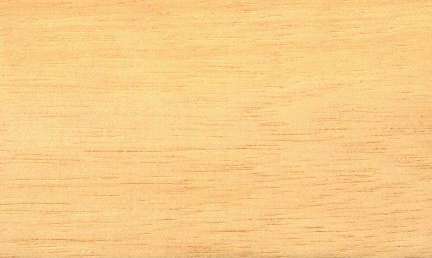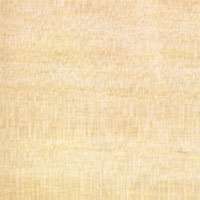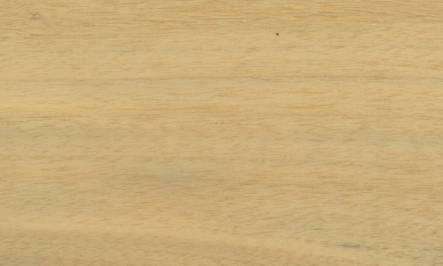   
Avodire (Turraeanthus africanus)
Family: Meliaceae
Common names: Adoma, African furniture wood, African satinwood, Agbe, Agbouain, Agboue, Agboui, Aneadwen, Aniadwen, Anyadwe, Apapaye, Apata, Apaya, Apeya, Appayia, Assama, Avodere, Avodire, Blimah-pu, Blimahpu, Duabedom, Engan, Enyaadwene, Esu, Gakrada, Guaso, Gyakrada, Hadwe, Hague, Hakue, Kakne, Kisanda, Kwadwema, Lusamba, M'fube, Oduma, Olon, Songo, Sunkroasu, Wansenwa, White mahohany, Wogya, Wonzanwa
Distributed in: Angola, Benin, Cameroon, Congo, Equatorial Guinea, Gabon, Ghana, Ivory Coast, Liberia, Nigeria, Sierra Leone, Uganda, Zaire (Africa)
Distribution overview: Avodire is distributed in tropical Africa, from Sierra Leone to the Congo region and Angola, and is most common in the eastern region of Ivory Coast. It is usually found in dense stands in rain forests, alongside lakes and streams.
Common uses: Boat building (general), Boxes and crates, Cabinetmaking, Chairs, Chests, Concealed parts (Furniture), Cooperages, Core Stock, Decorative veneer, Desks, Dining-room furniture, Dowell pins, Dowells, Drawer sides, Drum sticks, Excelsior, Figured veneer, Fine furniture, Floor lamps, Flooring, Furniture , Furniture components, Furniture squares or stock, Furniture, Hatracks, Joinery, Kitchen cabinets, Light construction, Living-room suites, Millwork, Moldings, Musical instruments , Office furniture, Organ pipes, Paneling, Particleboard, Piano keys, Pianos , Plain veneer, Plywood, Pulp/Paper products, Radio - stereo - TV cabinets, Rustic furniture, Sounding boards, Stools, Tables , Utility furniture, Vats, Vehicle parts, Veneer, Veneer: decorative, Violin bows, Violin, Wardrobes, Xylophones
Product sources: The ITTO reports that timber from this species is produced regularly but in low quantities and is exported regularly. The material is exported from the Ivory Coast to the world market in log form. Quantities are low and price is usually in the moderate range. The price of Avodire varies with grade and type of grain in the veneer. Avodire veneer of architectural grade is in the moderate price range.
Environment profile: Vulnerable in parts of its natural habitat
Tree size: Tree height is 20-30 m
Colors: the heart isWhite to cream, Yellow to golden-yellow to orangeand the sapwoodRed, Same as heartwood.The grain isWavy, the textureMediumand the lusterPronounced
Natural durability: Susceptible to attack from termites (Isoptera), Susceptible to marine borer attack
Odor: No specific smell or taste
LightInduced Color Change: Darker
Kiln Schedules: UK=E US=T6D2/T3D1 Fr=5
Kiln Drying Rate: Fairly rapid (11-17 days for boards under 32 mm, to 31-51 days for boards greater than 63 mm)
Drying Defects: Slight cupping, Slight twist/warp
Ease of Drying: Use care to avoid degrade
Tree Identification: Bole/stem form is not buttressed
Comments: General finishing qualities are rated as good
Blunting Effect: Slight dulling effect on cutting tools
Boring: Moderately easy
Interlocked and wavy grain may interfere with boring, but the material works fairly well with ordinary machine tools
Carving: Easy to carve
Slight dulling effect on cutting edges
Cutting Resistance: Saws well
Gluing: Good gluing properties
Mortising: Responds well to machine tools in mortising operations
Sight blunting effect on cutting edges
Moulding:
A French head is recommended for better in moulding operations
Movement in Service:
A French head is recommended for better in moulding operations
Nailing: Possible if prebored, Pre-boring recommended
Planing: Special attention required
Resistance to Impregnation: Sapwood is permeable
Response to hand tools: Variable qualities
Routing recessing: Good in both routing and recessing.
Sanding: Good sanding properties
Veneering qualities: Easy to cut
Steam bending: Very poor
Screwing: Good screwing properties, Screwing yields good results; Turning: Special attention required
Material containing interlocked or wavy grain may require a reduced cutting angle of 15 degrees for smooth, finished surfaces
Painting: Good
Painting qualities are good, but quartersawn surfaces may be uneven.; Polishing: Yields a shiny surface ; Staining: Stains well;
- Numerical data Metric
- Numerical data English
- Strength properties
- References
 |
 |
 |
 |
| Item |
Green |
Dry |
Metric |
| Specific Gravity |
0,47 |
0,53 |
|
| Density |
|
544 |
kg/m3 |
| Bending Strength |
657 |
964 |
kg/cm2 |
| Crushing Strength |
301 |
496 |
kg/cm2 |
| Hardness |
|
567 |
kg |
| Impact Strength |
|
65 |
cm |
| Shearing Strength |
|
168 |
kg/cm2 |
| Stiffness |
78 |
99 |
1000 kg/cm2 |
| Tangential Shrinkage |
6 |
|
% |
| Radial Shrinkage |
4 |
|
% |
| Weight |
576 |
512 |
kg/m3 |
| Maximum Load |
0,35 |
0,56 |
cm-kg/cm3 |
| Toughness |
|
|
cm-kg |
| Static Bending |
|
|
kg/cm2 |
|
 |  |  |  | | Item | Green | Dry | English | | Bending Strength | 9351 | 13712 | psi | | Density | | 34 | lbs/ft3 | | Hardness | | 1250 | lbs | | Impact Strength | | 26 | inches | | Maximum Crushing Strength | 4289 | 7065 | psi | | Shearing Strength | | 2403 | psi | | Stiffness | 1119 | 1413 | 1000 psi | | Work to Maximum Load | 5 | 8 | inch-lbs/in3 | | Specific Gravity | 0.47 | 0.53 | | | Weight | 36 | 32 | lbs/ft3 | | Radial Shrinkage | 4 | | % | | Tangential Shrinkage | 6 | | % | | Volumetric Shrinkage | 12 | | % | |
Max. crushing strength = medium 0
Shrinkage, Tangential = small 0
Density (dry weight) = 31-37 lbs/cu. ft. 0
Modulus of Elasticity (stiffness) = very low 1
Bending strength (MOR) = low 1
Shrinkage, Radial = very small
Bending strength (MOR) = medium
Shrinkage, Radial = small
Hardness (side grain) = medium
Bending strength (MOR) = high
Toughness-Hammer drop (Impact Strength) = low
Shrinkage, Tangential = moderate
Shrinkage, Radial = moderate
Shearing strength (parallel to grain) = very high
Shearing strength (parallel to grain) = high
Hardness (side grain) = soft
Modulus of Elasticity (stiffness) = low
Max. crushing strength = high
Work to Maximum Load = very low
Shrinkage, Tangential = fairly large
Shearing strength (parallel to grain) = very low
Shearing strength (parallel to grain) = medium
Modulus of Elasticity (stiffness) = medium
Density (dry weight) = 38-45 lbs/cu. ft.
Density (dry weight) = 23-30 lbs/cu. ft.
Bending strength (MOR) = very high
Avodire exhibits similar machining characteristics to those of the mahoganies since they are in the same botanical family. It is also reported to have almost the same strength properties as English oak (Quercus ), although it is about 15 percent lighter. The wood is slightly better to work with than Primavera. It is rated as medium in crushing and bending strengths, and low in shock resistance and stiffness. Hardness is rated as medium, weight is about average, and it has high density. Timber produced by the species is often mixed and marketed with that ofTurreanthus vignei .
Armstrong, F.H.,1960,The Strength Properties of Timber,Forest Products Research Laboratory, London Bulletin,No.45Banks, C.H., Schoeman, J.P., Otto, K.P.,1977,The Mechanical Properties of Timbers with particular reference to South,Africa,South African Forestry Research Institute Bulletin,(Ed.,Schoeman, J.P. 1973 & Otto K.P. 1976,No.48Banks, C.H.,1954,The Mechanical Properties of Timbers with Particular Reference to those,grown in the Union of South Africa,Journal of the South African Forestry Association,No. 24 pp.44-65,[South,African Forestry Journal]Bentum, A.L.K.,1968,Properties of Ghanian Timbers - Avodire,Ghana Forest Products Research Institute Technical Newsletter,2(1,pp13-4Bois et Forets des Tropiques,1956,Avodire (Turraeanthus africana,Bois et Forets des Tropiques,No.49, pp19-22Bois et Forets des Tropiques,1976,Moabi (Baillonella toxisperma,Bois et Forets Tropiques,n0.169, pp37-49Bolza, E., Keating, W.G.,1972,African Timbers - the Properties, Uses and Characteristics of 700 Species,C.S.I.R.O. Div. of Building ResearchBoone, R. S., C. J. Kozlik, P. J. Bois, E. M. Wengert.1988.Dry Kiln Schedules for Commercial Woods - Temperate and Tropical. USDA., Forest Service, Preliminary Copy, Forest Products Laboratory, Madison, Wisconsin.Brown, W.H.,1969,Properties and uses of Tropical hardwoods in the United Kingdom. Part 1,Nonstructural properties and uses.,Conference on Tropical hardwoods SC-5/TN-5, Syracuse UniversityBrown, W.H.,1978,Timbers of the World No.1 Africa,TRADA, Red Booklet SeriesChudnoff, M.,1984,Tropical Timbers of the World,U.S.A. Department of Agriculture, Forest Service, Forest Products,Laboratory, Madison.Cox, H.A.,1939,A Handbook of Empire Timbers,Forest Products Research Laboratory, Princes RisboroughEdlin, H.L. 1969. What Wood is That?: A Manual of Wood Identification. A Studio Book, The Viking Press, New York.Erfurth, T., Rusche, H.,1976,The Marketing of Tropical Wood A. Wood Species from African Moist Forests,F.A.O. Forestry DepartmentFarmer, R.H.,1972,Handbook of Hardwoods,HMSOForest Products Research Laboratory, U.K.,1950,The Seasoning Properties of Exotic Timbers,Forest Products Research Laboratory, Princes Risborough, Department of,Science and Industrial Research Leaflet,No.44 and supplements 1 & 2Forest Products Research Laboratory, U.K.,1955,Kiln-Drying Schedules,Forest Products Research Laboratory, Princes Risborough, Department of,Science and Industrial Research, Building Research Establishment Leaflet,No.42Forests Products Research Laboratory, U.K.,1956,A Handbook of Hardwoods,Forest Products Research Laboratory, Princes Risborough, Department of,Science and Industrial Research, Building Research EstablishmentFortin, Y., Poliquin, J.,1976,Natural Durability and Preservation of 100 Tropical African Woods,International Development Research Centre, CanadaFouarge, J.,1953,Bois du Congo,I.N.E.A.C.France - C.T.F.T.,1966,Bois Tropicaux,C.T.F.T. Publ.,12Ghana - Timber Marketing Board,1969,Ghana Hardwoods,Timber Marketing BoardHarrar, E.S.,1942,Some Physical Properties of Modern Cabinet Woods 3. Directional and Volume,Shrinkage,Tropical Woods,9(71, pp26-32HMSO.1981.Handbook of Hardwoods, 2nd Edition.Revised by R. H. Farmer.Department of the Environment, Building Research Establishment, Princes Risborough Laboratory, Princes Risborough, Aylesbury, Buckinghamshire.Hughes, J.F.,1971,The Principal Timber Trees of Cameroon,Unpublished dataIrvine, F.R.,1961,Woody Plants of Ghana,O.U.P. LondonITTO.1986.Tropical Timber Atlas, Volume 1 - Africa.International Tropical Timber Organization (ITTO) and Centre Technique Forestier Tropical (CTFT, 45bis, Avenue de la Belle Gabrielle, Nogent-sur-Marne Cedex, France.Jane, F.W.,1951,The Structure of Timbers of the World (Part 5,Timber News,59(2149,pp484-7Jay, B.A.,1968,Timbers of West Africa,TRADA, Red Booklet SeriesKaiser, J. 1990. Wood of the Month - Avodire: The Light African Wood with Hidden Strength. Wood of the Month Annual, Supplement to Wood and Wood Products, September, 1990. Page 22A.Keay, R.W.J.1989. Trees of Nigeria.Revised Version of Nigerian Trees. Clarendon Press, Oxford.Kinloch, D., Miller, W.A.,1949,Gold Coast Timbers,Govt. Printer Gold CoastKline, M. 1979. Turreanthus africanus - Avodire. In A Guide to Useful Woods of the World. Flynn Jr., J.H., Editor. King Philip Publishing Co., Portland, Maine. 1994. Page 354.Koeppen, R.C., Kukachka, B.F.,1961,Avodire (Turraeanthus africana,U.S.A. Department of Agriculture, Forest Products Laboratory, Madison,,Foreign Wood Series No. 1905Kribs, D.A.,1950,Commercial and Foreign Woods on the American Market (a manual to their,structure, identification, uses and distribution,U.S.A. Penn. State College, Tropical Woods LaboratoryKukachka, B.F.,1970,Properties of Imported Tropical Woods,Forest Research Paper FPL 125Lavers, G. M.1966.The Strength Properties of Timbers.Forest Products Research Bulletin, No. 50.Ministry of Technology, Her Majesty's Stationery Office, London.Lavers, G.M.,1983,The Strength Properties of Timber (3rd ed. revised Moore G.L.,Forest Products Research Laboratory, Princes Risborough, Building Research,Establishment Report (formerly Bulletin No.50)Lincoln, W. A.1986.World Woods in Color. Linden Publishing Co. Inc., Fresno, California.Miller, C.M.,1951,Foreign Woods-Avodire (Turraeanthus africana,U.S.A. Department of Agriculture, Forest Products Laboratory, Madison,,Info. Leaflet Report, No.1905Organisation for European Economic Co-operation,1951,African Tropical Timber (Nomenclature, Description,OEECPatterson, D.,1988,Commercial Timbers of the World, 5th Edition,Gower Technical PressPieters, A.,1977,Essences Forestieres du Zaire,R.U.G. Gent BelguimRendle, B.J.,1969,World Timbers (3 Vols.,Ernest Benn Ltd. LondonRevue des Bois et de ses Applications,1957,La page des bois tropicaux - Avodire,Revue des Bois et de ses Applications,12 (3, p35Sallenave, P.,1955,Proprietes Phyiques et Mecaniques des Bois Tropicaux de l'Union Francaise,C.T.F.TSallenave, P.,1971,Proprietes Physiques et Mecaniques des Bois Tropicaux (Deuxieme,Supplement,C.T.F.T.Spalt, H.A., Stern, W.L.,1959,Survey of Africa Woods 4,Tropical Woods 17(110) pp42-115Takahashi, A.,1978,Compilation of Data on the Mechanical Properties of Foreign Woods (Part,III) Africa,Shimane University, Japan, Research Report on Foreign Wood No. 7Timber Development Association Ltd.,1955,World Timbers (3 Vols.,Timber Development Association Ltd.U.S.D.A. Forest Service,1974,Wood Handbook,U.S.A. Department of Agriculture, Forest Service Handbook,72USDA.1987.Wood Handbook - Wood as an Engineering Material, Forest Service, Agriculture Handbook No. 72, Forest Products Laboratory, Madison, Wisconsin.USDA.1988.Dry Kiln Operator's Manual - Preliminary Copy.Forest Service, Forest Products Laboratory, Madison, Wisconsin.WCMC.1992.Conservation Status Listing - Trees and Timbers of the World, World Conservation Monitoring Centre, Plants Programme, 219 Huntingdon Road, Cambridge, CB3 ODL, United Kingdom.Wood, B., Calnan, D.,1976,Toxic Woods,British Journal of Dermat 94 Suppl. 13
|











